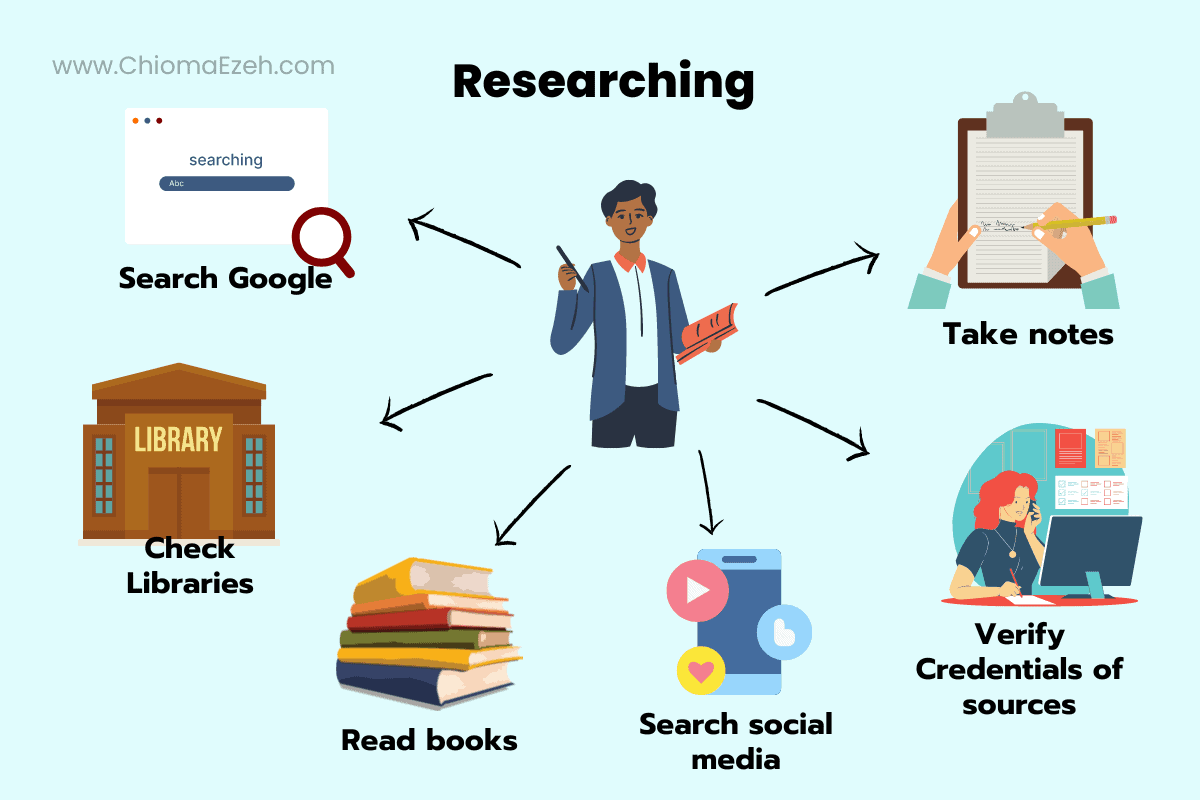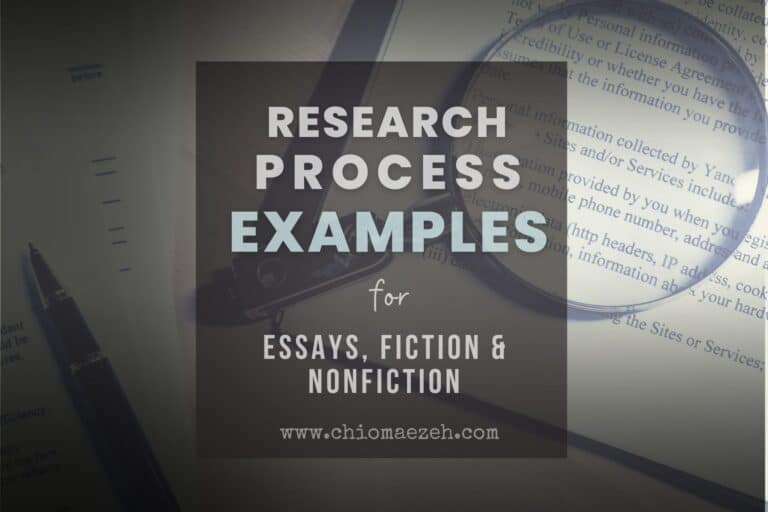The Research Process: 7 Steps For Creating Credible & Helpful Content
Modern readers are smart and informed. They care about accurate facts. That’s why you need to find out everything there is to know about a specific topic.
You can use sources that range from library books to internet articles for your research. Remember the main aim at this stage is to find out as much as you can about your topic. Read as widely as you can, and talk to experts if necessary.
Even fiction authors are advised to do some research. The last thing you want to do is claim your character rode a bicycle from Toronto to Tokyo in fifteen minutes. You need to get your facts straight if you want readers to trust you.
By breaking down the research process into these seven simple steps, it becomes easier to manage your work and stay organized throughout your project. This article will outline each step and provide examples to illustrate their purpose.
👉 New and don’t know where to begin? Head over to our comprehensive guide on the writing process to get started

What Is Research In The Writing Process?
Research is a critical step in the process of finding solutions to problems, making decisions, and forming opinions. It involves gathering information from reliable sources to help inform our understanding on any given topic or issue.
The research process typically follows a set of seven steps that can be used for answering questions, solving problems, and uncovering new knowledge. The 7 steps include:
- Identifying the topic
- Research question
- Gathering resources
- Evaluating resources
- Analyzing data
- Drawing conclusions
- Presenting findings
Let’s Talk
Are you a writer aspiring to pen a masterpiece that never fails to captivate? Look no further. Reach out to us and uncover how we can help you to take your writing to unprecedented heights!

What Are The Types Of Research In Prewriting?
in rewriting, the types of research that might be done include: gathering background information and data, conducting interviews, researching current or past events, exploring available resources, observing people or situations in person or online.
However, generally, there are five basic types of research methods. They include quantitative approaches such as surveys and tests, qualitative methods such as action research and interviews, and mixed methods which combine elements of both quantitative and qualitative analysis, case studies which involve an in-depth investigation into a particular person or situation, and surveys which collect data from a sample population.
All these different types of research can be used to collect data and explore different topics. However, as a writer, there are specific types suitable for your needs.
👉 To learn more, head over to our guide on the types of research methods you need to know and use as a writer!
Guidelines On The Research Process
Here are good research guidelines you can follow:
- Browse through books from the section of the library that contains books on your topic – don’t be hesistant to ask the librarian for recommendations.
- Type the keywords of your idea into a search engine like Google – you can use quotation marks to get more specific results.
- Check the history and credentials of the person who wrote what you read in order to establish credibility – not every source is accurate or trustworthy, especially on the internet.
- Skim and scan materials so you don’t spend too much time researching.
- Take down notes as you research – you don’t want to forget important concepts you come across during your research.
Research is the first and one of the most important steps in the 9-step prewriting process. Using incorrect information means you will come across as ignorant and lazy to your readers. This could potentially ruin your career, seeing as readers have no reason to trust anything else you write in the future.
👉 See our complete 9-step prewriting process, so you don’t miss out on important steps!
The Research Process Steps
1. Identify your topic.
The first step in the research process is to identify your topic. To do this, you need to consider what areas of interest you want to explore and what specific questions can be asked about them. Once you’ve done this, narrow it down to a manageable size.
For example, as an author, you may decide to research the history of the novel. To narrow this topic down, you might focus on a specific period in time, such as Victorian literature.
2. Develop a research question.
After you have identified your topic, the next step is to develop a research question. This should be a single sentence that summarizes what you want to investigate and why. Your research question should be specific enough that it can be answered in a limited amount of time without becoming overwhelming or too broad.
If yu want to use this same scenario for your novel, your research question might be: “What were the key themes and literary techniques used in Victorian novels?”
3. Gather the necessary information.
Once you have identified your research question, the next step is to begin gathering the necessary information to answer it. This means finding books, journal articles, websites, and other sources of information that relate to your topic. Be sure to take notes on any important points or quotes as you go along so you can easily refer back to them later.
So, this basically entails reading existing literature in the field and conducting interviews, surveys, and experiments. Here are some examples of activities that you can undertake during this phase:
- Reading textbooks, peer-reviewed articles, and other published research related to your topic
- Type the keywords of your idea into Google – you can use quotation marks to get more specific results.
- Interviewing experts in the field
- Developing and administering surveys
- Conducting experiments or field studies
- Using data sources such as census figures, statistics from governmental agencies, and historical documents
Using the previous example, while researching Victorian literature, you could conduct interviews with professors who specialize in the field, read books from the library on the topic, and search for articles online.
4. Evaluate resources.
Once you have gathered your resources, the next step is to evaluate them. This includes assessing their relevance and accuracy in relation to your research question. It is important to consider the author’s credentials when evaluating a resource, as well as any potential biases they may have. Check the history and credentials of the person who wrote what you read in order to establish credibility – not every source is accurate or trustworthy, especially on the internet.
For example, as an author researching Victorian literature, you may want to read books from the library written by respected scholars in the field and compare them with online articles written by anonymous authors.
5. Analyze your data.
The next step is to analyze the information you have gathered and draw conclusions based on it. This involves looking for patterns or trends that can help answer your research question. Be sure to include citations for any sources you use in your analysis, as well as provide an explanation of how the information you found is relevant to your research question.
Depending on your research question, different analytical methods may be used. For example:
- Quantitative analysis of numerical data including averages, correlations, and trends
- Qualitative analysis such as coding textual data or interpreting interview results
- Creating visual representations of data such as graphs, charts, and diagrams to make it easier to interpret
For example, after researching Victorian novels, you may come to the conclusion that many of them focused on themes such as social class and gender roles due to the needs of the time period. You would then back up this conclusion with evidence from your research, such as quotes and statistics.
6. Draw conclusions.
The final step of the research process is to draw your conclusions and present your findings. Be sure to include any relevant graphs, charts, or diagrams that help explain your findings. You should also provide an explanation of the importance of your research and its implications for future study.
7. Present your findings.
Finally, it is time to present your findings in a meaningful way. This can be done in a number of ways, from writing your book, a formal research report or paper to giving an oral presentation. The aim should be to clearly communicate the results of your research and make recommendations based on what you have discovered.
By following these steps, you can ensure that your research project is successful and provides meaningful results.
Research Process examples
Let’s assume you are writing a detailed piece on digital currencies. Here is how you might conduct your research using the steps we just discussed:
1. Identify your research question: What is the impact of digital currencies on the global economy?
2. Gather resources: You may need to look into economic and financial data, reports from banking institutions, news articles from media outlets, interviews with experts in the field, and more.
3. Research: Skim through the available materials to get a basic understanding of different perspectives on digital currencies. Read books and articles written by experts in the field, watch documentaries on the subject, and read reports from banking institutions. Steps involved may include:
- Browse through the finance and economics section of the library. See if any of the book titles jump out at you. [Hint: Use our book title generator for exciting ideas!].
- Type “digital currencies” into your search engine. Encircle “digital currencies” inside quotation marks to get more specific results. Remember to try out various versions of the keyword, such as “internet money.”
- Focus on titles, subheadings, outlines, and the first sentence or paragraphs until something jumps at you. Otherwise, you may end up spending too much time researching instead of writing.
- Jot down notes. Make sure to also note down the source so you can find it later.
4. Evaluate resources: Assess the credibility of any sources you use – this means considering the author’s qualifications and experience when it comes to provide. You can google-search the people who wrote the sources you are going through. In this specific case, try to go with people who either have degrees in finance or computer science, professionals who’ve been in the industry for years, or writers published by reputable publications such as the Economist and the New York Times.
5. Analyze your data: Look for patterns or trends that help answer your research question. This may include creating visual representations of any numerical data you find, coding textual data from interviews,or looking for correlations between economic indicators.
6. Draw conclusions: Draw your own conclusions about the research question and present them in a meaningful way. Explain why you think digital currencies are having an impact on the global economy and discuss any implications for future study.
7. Present your findings: Finally, present your findings in whatever manner is most appropriate. This could mean writing up a report or paper, giving an oral presentation at a conference, or publishing your findings online.
Research can either make or break your project. Be diligent with this step.
👉 Want more examples? See our Research process examples for various fiction and nonfiction topics!
Research Process exercises
Do the following:
- Go to the library. Spend an hour researching the history of your country.
- Use the internet to search for the first-ever software engineer.
- Choose any source you came across in 1 or 2. Try to find out as much as you can about the person who created that source.
- Use the steps we discussed in this section to research any topic of your choice.
👉 Want to practice and hone your research skills? Use our helpful exercises to get yourself equipped!
Final notes on the Research Process
No matter what type of research you are conducting, it’s important to document your process in detail. This can include keeping a log of the sources you use and any decisions made during the investigation. Doing this will not only help you stay organized but also provide evidence to support any claims or conclusions you make.

![Outlining In Writing: 6 Easy Steps For Success [With Formats]](https://chiomaezeh.com/wp-content/uploads/2023/01/What-is-outlining-in-writing-process-768x512.jpg)
![What Is Brainstorming in Writing? [Explained For Writers & Authors]](https://chiomaezeh.com/wp-content/uploads/2023/02/What-is-brainstorming-in-writing-768x512.jpg)


![Types of Audiences In Writing [Explained]](https://chiomaezeh.com/wp-content/uploads/2023/02/Types-of-audiences-in-writing-768x512.jpg)
![What Is Second Person Point Of View? [Definition & Examples]](https://chiomaezeh.com/wp-content/uploads/2023/03/second-person-point-of-view-1-768x512.jpg)